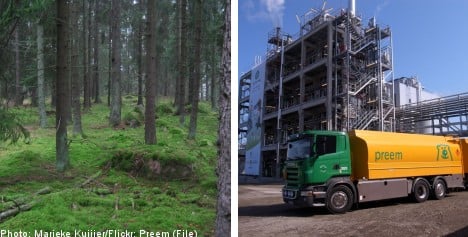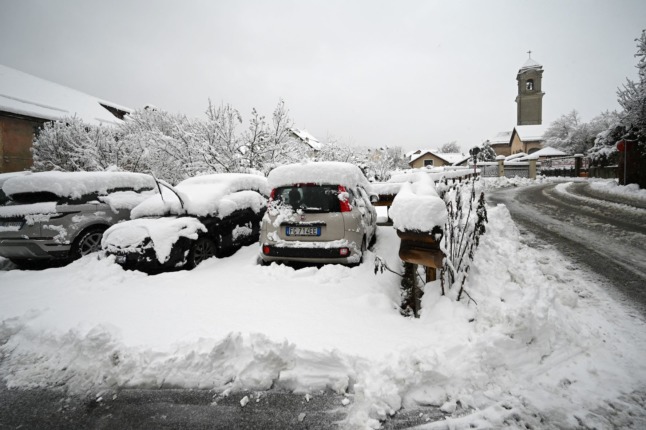For decades, scientists have been foraging for viable alternative energy sources that don’t rely on the planet’s shrinking natural fossil fuel resources.
In recent years, rising concerns over traditional fuel’s harmful pollutants sparked a global rage for biofuels derived from biomass ranging from discarded corn husks to animal fats.
Earlier this year, Preem, a leading Swedish oil company, emerged as the world’s first company to offer an innovative biodiesel made from tall oil, a renewable by-product of the forestry industry.
“The future is our market and we know that we need to find new roads to replace fossil fuels,” says Thomas Ögren, spokesperson for Preem.
“We have a lot of tall oil in Sweden and now we have a process to make diesel from it.”
Known as Preem Evolution Diesel, this green diesel is composed of about one fifth raw material and according to the company, cuts carbon emissions by 16 percent when compared to traditional diesel, which corresponds to the leading carbon emissions rate-cut of any biodiesel on the market.
“The best thing about our biodiesel is that every diesel engine can drive with it, it doesn’t require a special engine, and it can be mixed with other diesels – it’s an easy choice,” adds Ögren.
The idea for using tall oil, a component also found in adhesives, inks, rubber and drill fluids, came from a creative Swedish entrepreneur Lars Stigsson.
After an initial meeting between Stigsson and Preem executives, a plan was hatched that drew in two other partners, forestry companies Södra and Sveaskog.
Six years later, with more than 65,000 work hours logged, 2 million test-kilometres driven and more than 600 million kronor ($96.5 million) invested, Evolution was born.
Its creation and launch outpaced competitors in Italy, Brazil and Ireland with similar research initiatives and attempts underway and by early April, Preem’s Evolution Diesel has been launched in 370 of their 600 stations across Sweden.
“We already had the best standard diesel in the world because it has fewer particles in it and now, with Evolution, no one in the world has a better diesel,” says Ögren, adding that the expensive initiative was entirely funded by private money as Preem received no help from the state.
Tall oil, also known as liquid rosin, is a gummy, yellow-black odorous residue extracted from black liquor when pulping mostly coniferous trees.
It has previously been considered a waste product by the paper and pulp industry.
“In the past, we delivered fuel to members of the forestry industry, but today they are the ones delivering fuel to us,” says Ögren of the new use found in tall oil and its increase in product value to foresters.
Now the raw material is collected, reprocessed and then split to a molecular level that is identical to regular petro-based diesel molecules at Preem’s new factory in Piteå in northern Sweden.
The tall oil is then transported to a refurbished bio-refinery in Gothenburg in southwestern Sweden where the product is further refined and then mixed with fossil diesel, resulting in Evolution.
Whereas most biodiesels on the market today offer a blend of 5 percent renewable material, Preem’s Evolution is a mix that consists of about 15 percent tall oil and 5 percent rapeseed oil, setting a new global height for renewable content.
In theory, the matching molecular structure between the two diesel components could make it possible to blend higher ratios of tall oil diesel with petro-based diesel, thus creating greener diesel fuels in the future.
Preem aims to produce about 100,000 cubic metres of crude tall oil per year and claims that diesel vehicles that run on the Evolution fuel will have the same torque, the same power, and attain the same fuel efficiency as ordinary diesel while not costing a single krona more.
“Our customers like easy choices and it is very important for us to give a better product at the same price,” says Ögren, who also states that if the government installs a tax on the currently exempt biodiesel fuel it will be “too expensive” to sell in Sweden.
The 16 percent reduction in carbon dioxide emissions, when compared to traditional fossil diesel, amounts to about 250,000 tonnes.
Preem says this is the equivalent to the emissions from 120,000 cars per year.
Statistics from the national green vehicle organization, MiljöFordon, show a total of 4.6 million cars registered in Sweden, which means Preem’s reduced emissions amounts to less than 3 percent of the total number of vehicles in the country, however.
In addition, reports by the Swedish Environmental Protection Agency (Naturvårdsverket) show that Sweden has the most fuel-thirsty fleet of vehicles in the European Union, and the carbon dioxide emissions of new petrol and diesel cars are still among the very highest despite a decrease of 5 percent in recent years.
And while Preem’s Evolution Diesel has received plaudits globally as a step forward, concerns about the sustainability of tall oil remain.
“It is a good product, but we should also be aware that the world’s tall oil (supply) is very limited and this blend will only serve a fraction of the need,” says Lars Lind, a biofuel expert employed with the Swedish specialty chemical company Perstorp.
“It is quite a big investment for a small impact with a quite limited raw material. While this is a step in the right direction, there are other alternatives to tall oil that are much more effective and should continue to be explored.”
Other biofuels on the market mentioned by Lind include those produced from vegetable oils, such as rapeseed, canola, soy and palm. Due to their need to share available arable land, these blends have sparked a frenzied debate around the impact caused to the food industry.
While Ögren applauds Evolution’s effectiveness and praises its independence from affecting food production, he does admit to tall oil’s limited availability.
“Tall oil cannot replace all fossil fuels in diesel but it is one of several solutions,” he explains.
“We must continue to find a mix of several renewable sources and continue to assess new alternative and sustainable sources that we have here in Sweden,” Ögren states.
Lind agrees.
“Diesel replacement is the best way forward since diesel engines are the best engine. And there is space in the market for all replacement efforts.”




 Please whitelist us to continue reading.
Please whitelist us to continue reading.
Member comments